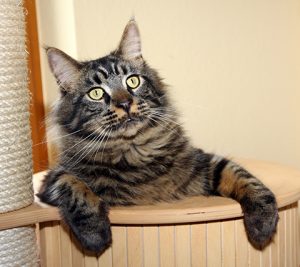Yes, actually they do! It’s a commonly held belief that cats don’t suffer from arthritis, but it’s unfortunately a myth. 
What is arthritis?
Arthritis just means “inflammation of the joints”, but when we use the term, we’re usually talking about osteoarthritis. This is the common “wear and tear” arthritis that older cats (and dogs, and horses, and people!) get, after a lifetime of activity.
As a general rule, there are three causes of arthritis:
- Normal loading on an abnormal joint – this is why you often see early onset of arthritis in cats who have injured a limb; the joint heals but may not be in perfect alignment, so there is increased wear.
- Abnormal loading on a normal joint – typically in obese cats, carrying excess weight.
- Normal loading on a normal joint for an abnormal length of time – in other words, old age!
There are other kinds of arthritis as well (septic arthritis, caused by infection, and immune arthritis, caused by certain diseases of the immune system), but osteoarthritis is by far the most common.
What does arthritis do to the joint?
In a joint, the bones don’t actually touch each other – they’re covered with a substance called cartilage, which acts as a kind of biological teflon, allowing the bones to glide smoothly over each other. To reduce friction even more, the joint is filled with a fluid (known, imaginatively, as joint fluid) which provides lubrication. This fluid is made by the synovial membrane which lines the inside of the joint capsule (the fibrous “balloon” around the joint that holds it together and keeps the fluid inside).
Whatever the underlying cause, arthritis results in wearing of the cartilage. As it is worn down, the cat’s body tries to compensate by producing extra lubricating fluid (resulting in swelling and pain). It may try to repair the cartilage, but this is unlikely to be successful, and so the joint tends to respond by growing extra bone around the edges to try and stabilise itself. Eventually, the cartilage “non-stick” layer is worn down until bone is grinding on bone.
So what are the symptoms?
All the symptoms of arthritis come down to joint pain and joint stiffness. An arthritic joint is usually:
- Filled with fluid (a synovial effusion).
- Painful (because of the cartilage damage, the excessive fluid, and the inflamed synovial membranes).
- Less mobile (because of the excess fluid and the extra bone growth).
Well my cat doesn’t limp, so he must be fine.
NO! Unlike dogs (who want everyone to know about it if they’re in pain!), cats will try to hide it for as long as possible. It’s very common for owners just to think their cat is suffering from old age, when actually they’re in severe pain because the common symptoms are:
- Reduced physical activity
- Reluctance to jump or climb
- Being less playful
- Grumpiness or bad temper
- Going off on their own to curl up away from people
What can be done about it?
The first thing to do if you suspect your cat has arthritis is to make an appointment to see one of our vets. Fortunately, there’s a lot you can do to help once the condition is diagnosed, and there are medications that are highly effective at relieving the symptoms.
- Management options include:
- Use of ramps – climbing stairs is difficult for an arthritic cat, so ramps can really help.
- Sunken or shallow litter trays – it can be hard for them to hop into a litter tray, so using a shallow tray, or one which is sunken or has a ramp, can be really helpful (as long as they can climb out again!)
- Use of ramps – climbing stairs is difficult for an arthritic cat, so ramps can really help.Sunken or shallow litter trays – it can be hard for them to hop into a litter tray, so using a shallow tray, or one which is sunken or has a ramp, can be really helpful (as long as they can climb out again!)
- Warm, comfortable sleeping places – yes, cats are great at finding these on their own, but it never hurts to help! A warm, well padded surface helps to minimise the pain from arthritic joints.
- Weight loss – 25% of UK cats are obese, and some studies suggest as many as 60% are overweight. Loss of one body condition score (for example, going from 7/9 to 6/9) is as effective in relieving arthritic pain as a dose of painkillers.
- Medical treatments:
Painkillers are the mainstay of managing an arthritic cat, especially the non-steroidal family of drugs (NSAIDs). However, NEVER use human painkillers in cats – many are lethally poisonous. It is also illegal to give a cat a human medication unless on a prescription written out by your vet. There are a wide range of different treatments available, mostly as tasty liquids to put on your cat’s food, so talk to one of our vets before you try anything else!
Joint supplements containing the “building blocks” for healthy cartilage (such as glucosamine and chondroitin are very popular. They may have an effect in some cats, but there isn’t much research into how effective they are.
If you think your cat is arthritic, make an appointment to see one of our vets so we can get them up and about again!
